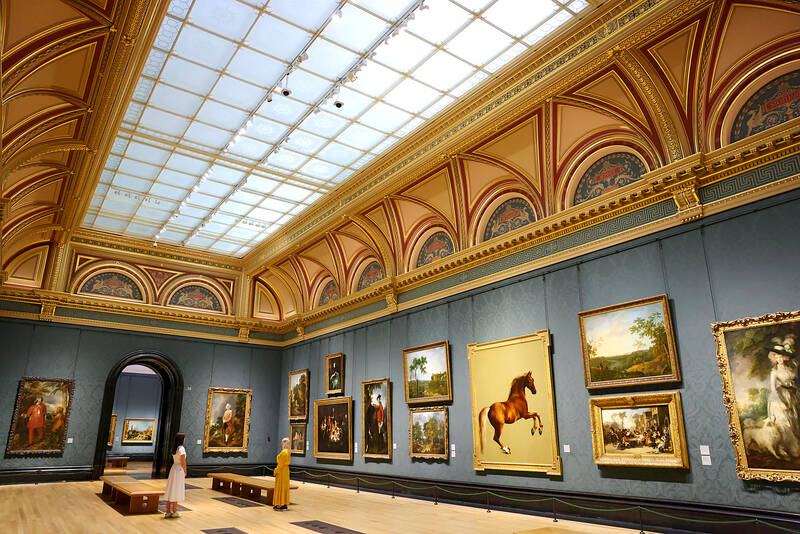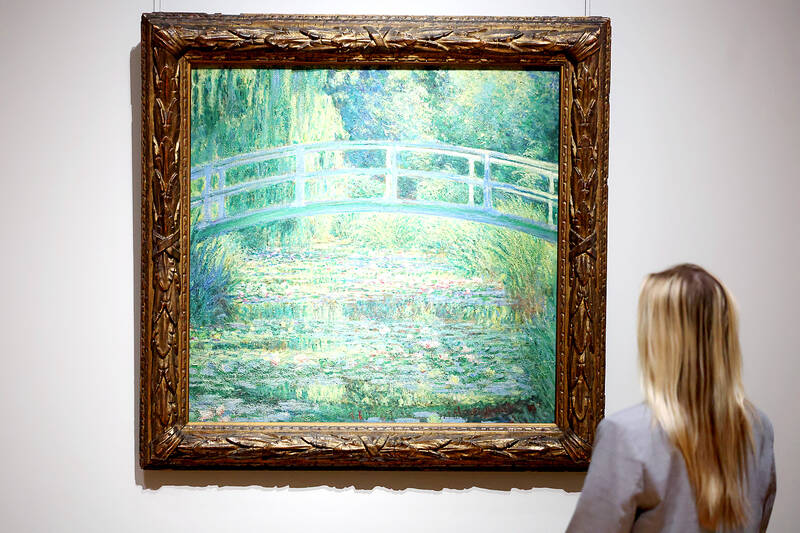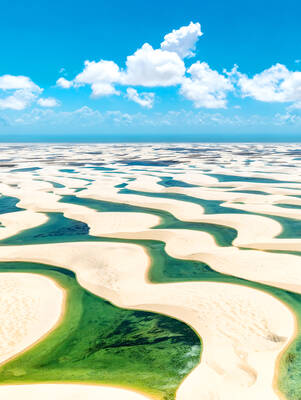Britain’s National Gallery announced on Sept. 9 that it will use a whopping £$375m (US$510m) in donations to open a new wing that, for the first time, will include modern art.
Founded in 1824, the gallery has amassed a centuries-spanning collection of Western paintings by artists from Leonardo da Vinci to J.M.W Turner and Vincent van Gogh — but almost nothing created after the year 1900. The modern era has been left to other galleries, including London’s Tate Modern.
That will change when the gallery opens a new wing to be constructed on land beside its Trafalgar Square site that is currently occupied by a hotel and offices. An architectural competition will be held to pick a design.

Photo: DiscoA340 /Wikimedia commons 照片:DiscoA340/維基共享資源
The gallery says money for the projects includes the two biggest donations ever publicly reported by any museum or gallery. It got £$150m (US$204m) from the Crankstart foundation founded by Silicon Valley venture capitalist Michael Moritz and his wife, writer Harriet Heyman, and the same amount from the Julia Rausing Trust run by Tetra Pak heir Hans Rausing. The remaining £$75m will come from the National Gallery Trust and an anonymous group of donors.
National Gallery director Gabriele Finaldi said the aim is “to be the place where the UK public and visitors from across the globe can enjoy the finest painting collection in the world from medieval times to our own, in a superb architectural setting.”
An old rivalry between two galleries

Photo: EPA-EFE 照片:歐新社
The gallery said it will build its collection of post-1900 works in collaboration with Tate, which holds the UK’s leading collections of British art and post-1900 international art.
Tension existed between Tate and the National Gallery for decades, fueled by the question of who should be allowed to collect “modern” art. The two institutions used to compete for the same works, with the Tate arguing that the cutoff point for the National Gallery should be 1900. That position was confirmed in an official agreement in 1996, but that line has never sat well with bosses at Trafalgar Square.
Maria Balshaw, the director of Tate, officially welcomed the announcement, saying it was planning to work closely with the National Gallery to “further the national collection as a whole.” Tate “looks forward to working closely with colleagues at the National Gallery on loans, curatorial and conservational expertise to support the development of their new displays,” Balshaw said.

Photo: AP 照片:美聯社
One person with knowledge of the situation said: “I know £$400m sounds like a lot of investment, but one Rothko is £$150m: if you want a Basquiat, it’s over £$100m. I understand that they’re over the moon with this amount of money, but I just think a reality check in favor of the national collection is important.”
Another source associated with the Tate said: “If the National Gallery collects, there will be competition for acquisition and much bad blood, as in the 1970s.”
Dilemma of deciding cutoff point

Photo: EPA-EFE 照片:歐新社
However, others involved at Tate welcomed the move. A senior figure, who asked to remain anonymous, told the Guardian: “What the National Gallery wants to do is perfectly understandable — they can’t really just stop right at a certain point as we get further away [from 1900], it starts to become more and more arbitrary.”
Successive National Gallery directors have argued that the barrier is arbitrary and awkward, meaning, for example, they can include everything that inspired cubism but not show any of the work because of when it was created.
When Finaldi became director of the National Gallery in 2016, he spoke about his frustration at the 20th-century cutoff, saying it was “slightly frustrating to reach 1900 and then not go on.”
On Sept. 9 Finaldi said the change in the collection policy was necessary because “as 1900 gets further and further away it will be natural for us to tell the bigger story.”
The announcement on Sept. 9 raises questions of where certain 20th-century painters would now sit.
A senior Tate figure who spoke to the Guardian used the example of what would happen to the work of David Hockney now the agreement has been torn up. “Do we want David Hockney to leave his works to Tate for use there and across the country or to the National Gallery?” they asked.
“We must have an agreement for donors and artists about where they leave their work,” said another source. “Otherwise, it’s just going to be a complete shambles.”
(AP and Guardian)
英國國家藝廊本月9日宣布,將以高達3.75億英鎊(5.1億美元)的捐款擴建側廳,並將首次有現代藝術作品展出。
國家藝廊成立於1824年,收藏了橫跨數世紀的西方畫作,包括從達文西到透納及梵谷等大師的作品,但幾乎沒有1900年以後的作品。現代藝術是留給其他美術館收藏,包括倫敦的泰德現代藝術館。
國家藝廊新側廂展廳開幕後,這種情況將有所改變。國家藝廊位於倫敦特拉法加廣場,擴建的預定地目前是酒店及辦公室。新展廳的設計將舉行競圖選出。
該計畫的資金包括兩筆博物館∕美術館有史以來公開過的最大捐款。國家藝廊從矽谷創投家麥可.莫里茨及其妻、作家哈里特.海曼創立的Crankstart基金會,以及利樂包公司繼承人漢斯.勞辛負責的朱莉亞.勞辛信託基金各獲1.5億英鎊(2.04億美元)的資助。剩餘的7,500萬英鎊則來自國家藝廊信託基金和一個匿名捐贈團體。
國家藝廊館長加布里埃爾.芬納迪表示,該館的目標是「讓英國民眾和世界各地的遊客能在一流的建築環境中欣賞到世界上最精美的繪畫收藏,從中世紀到我們的時代」。
兩館間的宿敵關係
國家藝廊表示,將與泰德藝術館合作,共同打造1900年後的藝術收藏。泰德藝術館收藏了英國首屈一指的英國藝術以及1900年後的國際藝術作品。
數十年來,泰德藝術館和國家藝廊之間一直存有緊張關係,爭點在於誰可以收藏「現代」藝術。這兩個機構過去常爭奪同個作品,泰德藝術館認為國家藝廊的收藏斷代點應為1900年。此立場在1996年的一項正式協議中確認,但國家藝廊的主管對此一直感到不滿。
但泰德藝術館館長瑪麗亞.巴爾肖對國家藝廊的宣布正式表達歡迎,並表示泰德藝術館計劃與國家藝廊密切合作,以「進一步擴大國家整體收藏的規模」,並表示泰德藝術館「期待與國家藝廊的同僚在借展、策展及修復方面密切合作,以支持他們開發新的展覽」。
一位知情人士表示:「我知道4億英鎊聽起來像是一筆不小的投資,但一幅羅斯科的作品就要1.5億英鎊;若你想要一幅巴斯奇亞的作品,那要超過1億英鎊。我知道他們為這筆錢欣喜若狂,但我認為,認清國家收藏的現實是很重要的」。
另一位泰德藝術館消息人士表示:「如果國家藝廊進行收藏,就會出現收購競爭,還會造成很多不和,就像1970年代那樣」。
收藏年代劃分之困境
泰德藝術館的其他相關人士對此舉則表示歡迎。一位知名不具的高層人士對《衛報》表示:「國家藝廊的舉動完全可以理解——隨著我們〔離1900年〕越來越遠,他們不能真的止步於某個點,這會變得越來越武斷」。
國家藝廊歷任館長都認為,這樣的界線過於武斷和尷尬,例如,他們可以收藏所有啟發立體派的作品,但卻不能展出立體派作品本身,因其創作年代晚於1900年。
芬納迪2016年出任國家藝廊館長時,曾談到他對20世紀收藏斷代點的不滿,稱「收藏到1900年卻無法繼續下去,這有點令人沮喪」。
芬納迪本月9日表示,收藏政策的改變是必要的,因為「隨著1900年離我們越來越遠,我們自然要講述更宏大的故事」。
本月9日的宣布引發了一些疑問,思考某些20世紀畫家現今該如何定位。
一位泰德藝術館的高層人士在接受《衛報》採訪時,以大衛.霍克尼的作品為例,說明收藏協議被打破後該何去何從:「我們希望大衛.霍克尼將其作品留給泰德藝術館和全國各地使用,還是留給國家藝廊?」
另一位消息人士表示:「我們必須和捐贈者及藝術家達成協議,談好他們作品的存放地點。否則,情況將變得一團糟」。
(台北時報林俐凱編譯)

A: Apart from megahit “KPop Demon Hunters,” what else is worth watching? B: The new shows featuring four top-tier actors – Xiao Zhan, Wang Yibo, Yang Yang and Li Xian — are all popular. A: Yang’s TV drama, “The Immortal Ascension,” is definitely one of the summer sizzlers. Some praise it as the Eastern edition of the glorious “Harry Potter” series. B: Yeah, the costume fantasy drama is about a young man’s journey to immortality. All the magic powers and magical tools in the show are just stunning. A: Let me go stream it now. I wanna

Rarely does Nature present such a striking contradiction as the one found in Lencois Maranhenses National Park. Located along Brazil’s northeastern coast, the park unveils breathtaking scenery, where rippling sands meet crystal-clear lagoons. Under the sun’s golden glow, the waters glitter in shades of turquoise and emerald. So surreal is this spectacle that visitors might wonder if they’re gazing at a digitally modified photo rather than a living landscape. Were it not for the unique geographical and climatic conditions, such a marvel would not exist. Unlike typical deserts, Lencois Maranhenses receives a substantial amount of rainfall, particularly during the rainy season

A: Wow, animated fantasy film “KPop Demon Hunters” (KDH) has become Netflix’s most viewed film ever. B: Isn’t that the movie about a K-pop girl group secretly serving as demon hunters? A: Yeah, and its theme song “Golden” was No. 1 on the Billboard chart. B: The hit performed by HUNTR/X — the girl group from KDH — has inspired a “Golden challenge,” as celebrities are racing to cover its sky-high notes. A: Cool, let’s try it out. A: 哇,動畫電影《KPop獵魔女團》近日已成為網飛上觀看次數最多的電影。 B: 這部電影不是關於某韓流女團,成員秘密擔任惡魔獵人的故事? A: 對,主題曲《Golden》更勇奪告示牌單曲榜冠軍呢! B: 該曲由電影中的女團「HUNTR/X」所演唱,甚至還掀起一股全球《Golden》大挑戰︰一堆名人挑戰翻唱該曲飆高音。 A: 酷喔我們也來挑戰吧。(By Eddy Chang, Taipei Times/台北時報張迪)

An automated human washing machine was one of the highlights at the Osaka Kansai Expo, giving visitors a glimpse into the future of personal hygiene technology. As part of the event, 1,000 randomly selected visitors were given the chance to try out this cleansing system. The machine operates as a capsule-like chamber where warm water filled with microscopic bubbles gently washes away dirt. The 15-minute process also includes a drying phase, removing the need for users to dry themselves manually. Equipped with advanced sensors, the device monitors the user’s biological data, such as their pulse, to adjust water temperature and other settings